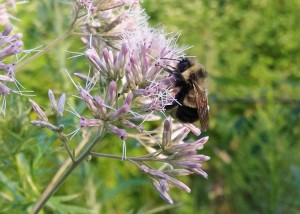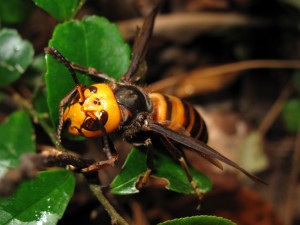The Fall of Rusty Patched Bumble Bees
Wednesday, January 18th, 2017January 18, 2017
For the first time in the continental United States, a wild bee has been designated as an endangered species. What was once a thriving bee in 28 states and 2 Canadian provinces, the rusty patched bumble bee is now weakly carrying on in scattered populations in just 13 states and the province of Ontario. In the past 20 years, the insect’s population has dropped 87 percent because of habitat loss, disease, pesticides, and climate change. In 2013, the Xerces Society for Invertebrate Conservation filed a petition for the rusty patched bumble bee to be listed as an endangered species, but it took until last week to make it happen.

The rusty patched bumble bee (Bombus affinis) was listed as an endangered species in January 2017. Credit: © Rich Hatfield, The Xerces Society
The bumble bee is a large, burly bee that often has mostly black-and-yellow coloring. Bumble bees may be seen flying among flower blossoms during spring, summer, and fall. The rusty patched bumble bee lives only in the upper Midwest and northeastern United States and in Ontario. Like most bumble bees, rusty patched bumble bees have black heads, but workers and males have a rusty reddish patch on their backs.
Bumble bees are among farmers’ best friends, and protecting them is important. They pollinate (help fertilize) numerous wild plants and such food crops as blueberries, cranberries, clover, and tomatoes. The agriculture industry leans heavily on such native pollinators as bumble bees.
Now that the rusty patched bumble bee is listed under the Endangered Species Act, the Fish and Wildlife Service must assess, protect, and help restore the insect’s population and habitat.
By protecting the environment, people can help save the rusty patched bumble bee. On an individual level, you can help simply by growing a garden. A garden of plants native to your region will attract and nurture native pollinators. Bumble bees love lupines (such as peas), colorful asters, and, as its name implies, bee balm (flowers that also attract nectar-loving butterflies and hummingbirds). Choose a variety of colorful plants that flower at different times, providing nectar and pollen throughout the growing season. Limiting or avoiding the use of pesticides and chemical fertilizers also helps, because they can kill or seriously harm bumble bees.




